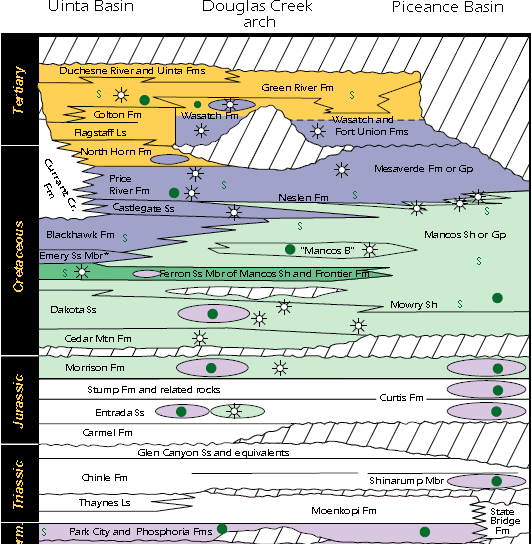Ferron Formation on:
[Wikipedia]
[Google]
[Amazon]
 The Ferron Sandstone Member of the Mancos Shale is a
The Ferron Sandstone Member of the Mancos Shale is a
 The Ferron Sandstone Member of the Mancos Shale is a
The Ferron Sandstone Member of the Mancos Shale is a geologic
Geology () is a branch of natural science concerned with Earth and other astronomical objects, the features or rocks of which it is composed, and the processes by which they change over time. Modern geology significantly overlaps all other Eart ...
unit in Utah
Utah ( , ) is a state in the Mountain West subregion of the Western United States. Utah is a landlocked U.S. state bordered to its east by Colorado, to its northeast by Wyoming, to its north by Idaho, to its south by Arizona, and to it ...
. It preserves fossils
A fossil (from Classical Latin , ) is any preserved remains, impression, or trace of any once-living thing from a past geological age. Examples include bones, shells, exoskeletons, stone imprints of animals or microbes, objects preserved in ...
dating back to the Cretaceous
The Cretaceous ( ) is a geological period that lasted from about 145 to 66 million years ago (Mya). It is the third and final period of the Mesozoic Era, as well as the longest. At around 79 million years, it is the longest geological period of th ...
period
Period may refer to:
Common uses
* Era, a length or span of time
* Full stop (or period), a punctuation mark
Arts, entertainment, and media
* Period (music), a concept in musical composition
* Periodic sentence (or rhetorical period), a concept ...
; and more specifically the middle Turonian.
Named by Lupton (1916), the formation is readily divisible into upper and lower members on the basis of both lithologic character and depositional history. Tectonic rejuvenation of adjacent provenance areas near the present Mount Nebo and Fish Lake Plateau shed coarser clastics eastward into the shallow seaway. This resulted in deposition of the widespread and persistent basal regressive marine sandstone of the Ferron.
Description
The Ferron Sandstone Member is bracketed by the overlying Blue Gate member of the Mancos Shale and the underlying Tununk Member of the Mancos Shale. It is composed of alternating yellow-gray, light-brown, and white sandstone, sandy gray shale, gray and carbonaceous shale, and coal. The sandstone is mostly fine to medium grained, calcareous, lenticular, thin to very thick bedded. It forms a resistant cliff above Tununk Member. The Ferron is 120 to 215 meters (400–700 ft) thick, thickening to the southwest. It is believed to represent flood dominated, marine-current and wave influenced deltas that drained the Cretaceous landscape.
Paleontology
A diverse collection of 13 species of shark teeth from the lower part of the Ferron Sandstone include: ''Hybodus'' sp., ''Ptychodus'' cf. ''P. mammillaris'' Agassiz, 1843, ''Ptychodus whipplei'' Marcou, 1858, cf. ''Chiloscyllium'' sp., ''Scapanorhynchus raphiodon'' (Agassiz, 1843), ''Cretodus crassidens'' (Dixon, 1850), cf. ''Leptostyrax'' sp., cf. ''Cretalamna appendiculata'' (Agassiz, 1835), ''Squalicorax'' sp., ''Pseudohypolophus mcnultyi'' (Thurmond, 1971), ''Protoplatyrhina hopii'' Williamson, Kirkland and Lucas, 1993, ''Ischyrhiza schneideri'' (Slaughter and Steiner, 1968), and ''Ptychotrygon triangularis'' (Reuss, 1844). The assemblage is typical of Turonian shark fauna.
A trackway made by a medium-sized ornithopod is known near the Moore Road Cutoff near the type section. Other vertebrates include a pteranodontoid pterosaur represented by wing bones,Bennett, S.C., 2018. A large pterodactyloid pterosaur from the Late Cretaceous Ferron Sandstone of Utah. ''Geological Society, London, Special Publications'', ''455''(1), pp.187-193. crocodilian teeth, a turtle shell fragment, and a small ornithopod ilium.Jud, N.A., Michael, D.D., Williams, S.A., Mathews, J.C., Tremaine, K.M. and Bhattacharya, J., 2018. A new fossil assemblage shows that large angiosperm trees grew in North America by the Turonian (Late Cretaceous). ''Science advances'', ''4''(9), p.eaar8568.
Fossil plants include giant 1.8 m diameter log of the angiosperm ''Paraphyllanthoxylon'', angiosperm leaves, and shoots of the confier ''Elatides curvifolia.'' These fossils indicate a mixed forest of angiosperm and conifer forests on the Turonian deltas.
See also
*List of fossiliferous stratigraphic units in Utah
This article contains a list of fossil-bearing stratigraphic units in the state of Utah, U.S.
Sites
See also
* Paleontology in Utah
References
*
{{DEFAULTSORT:Fossiliferous stratigraphic units in Utah
Utah
Stratigraphic units
A strat ...
* Paleontology in Utah
The location of the state of Utah
Paleontology in Utah refers to paleontological research occurring within or conducted by people from the U.S. state of Utah. Utah has a rich fossil record spanning almost all of the geologic column. During the ...
References
* {{cite web, title= Fossilworks: Gateway to the Paleobiology Database, author= ((Various Contributors to the Paleobiology Database)), url= http://www.fossilworks.org/cgi-bin/bridge.pl?action=home, access-date= 17 December 2021 Cretaceous geology of Utah